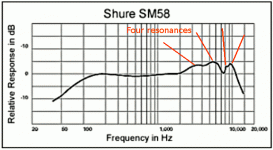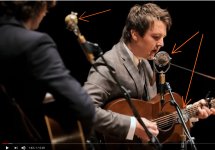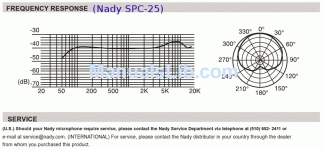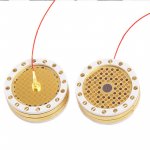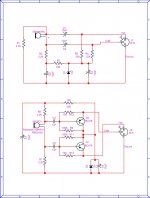I am putting together a DAW based on a Steinberg UR242 and Cubase 10. I've built a nice little PC and my DIY active 2 way monitors are coming along nicely but I want to get some microphones to start recording instruments and vocals.
I've got a lot of learning to do about microphones and their placement but I'm keen to experiment with different types. They will only ever be used in a home studio environment and always connected to the UR242 which has built in pre-amps and 48v phantom power over a balanced XLR connection.
Microphone modules seem to be cheap enough and I'm sure I can put together a case, but I'm getting confused about how to connect them to the UR242. A lot of DIY designs seem to include their own phantom power and pre-amp circuits, but if the UR242 already has these, do I still need to build them into a DIY mic?
Hopefully someone can help me clear the fog.
Many thanks.
I've got a lot of learning to do about microphones and their placement but I'm keen to experiment with different types. They will only ever be used in a home studio environment and always connected to the UR242 which has built in pre-amps and 48v phantom power over a balanced XLR connection.
Microphone modules seem to be cheap enough and I'm sure I can put together a case, but I'm getting confused about how to connect them to the UR242. A lot of DIY designs seem to include their own phantom power and pre-amp circuits, but if the UR242 already has these, do I still need to build them into a DIY mic?
Hopefully someone can help me clear the fog.
Many thanks.
It depends on the type of microphone capsule you intend to use.A lot of DIY designs seem to include their own phantom power and pre-amp circuits, but if the UR242 already has these, do I still need to build them into a DIY mic?
Dynamic mic capsules (such as the Shure SM57/SM58 widely used for loud, low-quality acoustic sources such as electric guitar) don't need either phantom power or a built-in preamp. The output signal is at a low impedance because of the way the mic capsule works, so it's fine to run several feet or a few metres of cable to an external preamp.
Condenser mic capsules are an entirely different thing. The "condenser" is only a few tens of pico farads, and this means the microphone has to work into an absolutely enormous load impedance - so high that it is absolutely essential to buffer it with an on-board mic preamp before running cables any distance to an external preamp.
That onboard preamp is also going to need DC power to work, and that's why condenser mic capsules always have electronics built-in, and usually need phantom power.
(I have a condenser mic that works off a 1.5V AA cell and doesn't accept phantom power, but this is the exception rather than the rule.)
Condenser mics, as I'm sure you know, are much more sensitive and much higher quality than dynamic mics, so they tend to be used whenever a source has subtle details to capture, or lots of high-frequency energy. In other words, you're going to need at least one of these in your studio!
-Gnobuddy
You could always get one of these mics if you plan for future DIY mods:
Mic Mods – Microphone-Parts.com
It seems you are at the beginning of building a mic collection. Start with a good dynamic and a good LDC. THE importing thing is to start, read, and experiment. Maybe search gearslutz for the answers you seek
Mic Mods – Microphone-Parts.com
It seems you are at the beginning of building a mic collection. Start with a good dynamic and a good LDC. THE importing thing is to start, read, and experiment. Maybe search gearslutz for the answers you seek
Condenser mics, as I'm sure you know, are much more sensitive and much higher quality than dynamic mics, so they tend to be used whenever a source has subtle details to capture, or lots of high-frequency energy. In other words, you're going to need at least one of these in your studio!
-Gnobuddy
I'm with you for most of your post, except this.
High-quality dynamic mics exist, and they sound really good. The Beyerdynamic M201TG, for example, sounds excellent. The AKG D224E is another example.
There are also lots of ribbon mics (which are a form of dynamic mic) which sound good.
Stanphink, I'd recommend taking a look on eBay or similar - you can buy dynamic mic capsules for a couple of pounds each. You can, if you like, connect those directly to an XLR connector and see what you get. Results will be variable, of course, but you'll be learning.
Chris
Let me start by saying that there is plenty of room for different opinions on this big planet.High-quality dynamic mics exist...
That said, very expensive dynamic mics certainly exist, but they always have a moving mass (diaphragm + coil former + coil) that is absolutely enormous compared to condenser microphones. This is unavoidable because copper wire is incredibly heavy compared to a wisp-thin film of Mylar, which is what the condenser mic usually uses.
You can't beat the laws of physics, and this (relatively) enormous moving mass of the dynamic mic leads to reduced sensitivity, and difficulty maintaining a flat frequency response out to the highest audio frequencies.
I looked up the technical data sheet for the Beyerdynamic M201TG, and it doesn't actually state the moving mass. Instead we get the claim "Low-mass moving coil transducer", which means absolutely nothing at all without the actual mass being provided. I would go so far as to say that the marketing department most probably left out the actual number, precisely so that people wouldn't realize how huge it is compared to any condenser mic diaphragm.
The datasheet also shows the manufacturers frequency response. While it is smooth compared to such horrors as the old SM58, it shows a resonance at about 12 kHz, with treble drooping above that. IMO, for three hundred bucks, that is a disappointing high frequency response, particularly when it is bettered by a Panasonic WM-61A electret condenser mic capsule, which used to cost less than a buck until Panasonic stopped making them (they now cost a whopping $2.33 Canadian each at Digikey!)
I know frequency response is not everything - the two-buck Panasonic will probably have higher self-noise because of its small diaphragm, and will overload at relatively low SPL). Still, a wide frequency response sells mics, so the fact that the $300 moving-coil mic falls an octave short of the full 20 Hz - 20 kHz audio range tells us something. (What it tells us is "copper is heavy!"
Moving coil mics are good at taking abuse from loud sources, so they make perfect sense for micing kick-drums and guitar amps, which generate no high frequency content anyway.
Mix engineers often have their idiosyncratic personal preferences. I knew (second-hand) one who used dynamic mics for his cymbals and high-hats, and a condenser mic on the kick-drum. Yeah, I don't know why, either!
Guitar Center (and other music gear retailers) sell cheap dynamic mics that invariably look like an SM58 on the outside, but inside, they omit the step-up transformer to save a few bucks, instead using an overwound (and therefore even heavier) moving coil wired directly to the XLR connector.eBay...dynamic mic capsules for a couple of pounds each...directly to an XLR connector...
I have given a few of these as presents to friends for karaoke and living-room singing, and they are just usable for that sort of thing. But they are really insensitive, and have a very limited frequency range.
I don't know anything about the Ebay capsules, though.
(But if you have an old pair of Sony Walkman earphones, they make quite good dynamic microphones, and don't cost $300 - in fact, Sony did the reverse when they engineered their Walkman, starting with one of their existing dynamic mics, and turning it into their then-revolutionary lightweight, high-quality, supra-aural (over-the-ear) headphones.
-Gnobuddy
> get some microphones to start recording instruments and vocals.
Shure SM58.
Not the last mike you will ever use. And comes from a line of fairly nasty mikes. But if you can't record it "clear" with an SM58, then change the player/singer. There's a reason SM58s are EVERYWHERE in pop music. The '58 is the SM57 with a pop filter. The SM57 (with foam filter) was THE microphone (in multiples) for the president of the USA from Nixon through Obama (the current incumbent seems to do it different). Politics aside, and ignoring extended range, the 57/58 are reasonably flat with a tailored presence peak, "bite", which may be over-familiar but does work.
-Then- buy/build other mikes for variety.
Shure SM58.
Not the last mike you will ever use. And comes from a line of fairly nasty mikes. But if you can't record it "clear" with an SM58, then change the player/singer. There's a reason SM58s are EVERYWHERE in pop music. The '58 is the SM57 with a pop filter. The SM57 (with foam filter) was THE microphone (in multiples) for the president of the USA from Nixon through Obama (the current incumbent seems to do it different). Politics aside, and ignoring extended range, the 57/58 are reasonably flat with a tailored presence peak, "bite", which may be over-familiar but does work.
-Then- buy/build other mikes for variety.
I have no trouble at all believing that. And IMO, it respects its heritage and continues the family tradition..."fairly nasty" is a very good description of the SM58!...comes from a line of fairly nasty mikes.
I have heard similar sentiments quite a few times before, and this widespread love for the SM58 truly leaves me scratching my head in puzzlement. This is one of those Twilight Zone experiences for me, because I have rarely heard a worse-sounding microphone, except in an intercom or a child's toy....if you can't record it "clear" with an SM58, then change the player/singer...
The factory frequency response looks to have been heavily smoothed to hide the worst of the microphone's sins, but even so, it shows multiple poorly controlled resonances (I can see at least four) between 3 kHz and 10 kHz. Peaks are up to 5 dB tall (!!). Above 10 kHz, the response falls like a rock. No wonder sibilants and "air" are destroyed by this mic.
In my experience, audio equipment with multiple closely spaced mechanical resonances in the midrange often sound "shrieky". The popular Bose linear array speakers and the SM58 both suffer from this "shrieky" sound quality.
The SM58 factory frequency response doesn't show the enormous bass boost that occurs due to the proximity effect - the microphone is so insensitive that singers are taught to "eat the mic". Directional microphones like the SM58 experience tremendous bass boost when closely spaced from the sound source, and this is why singers have that "singing from the bottom of a barrel" sound when they use an SM58; the sound guy/gal will routinely apply up to 15 dB of bass cut the moment he/she spots an SM58 on stage.
Among the singers I know, I have only heard one single one who sounded good through an SM58. That one singer is a woman with a high alto / mezzo soprano voice with a limited vocal range and no "air"; like many pop and folk singers and most amateur singers, she has had no vocal training and doesn't know how to use her head-voice, only her chest voice. She sounds fine through an SM58.
Every other singer I know has their voice badly mangled by this most popular of popular microphones. Basses, baritones, tenors, and contraltos all sound as though they are singing from the bottom of a barrel with a blanket draped over their heads. The bass is boomy and the treble simultaneously screechy in the midrange and muffled at the high end, with sibilance and "air" stripped away.
The muffled treble destroys the vocal quality of all singers who have a light airy voice. They sound as though they're singing through a pillow.
I have been very curious as to what that reason is, because, clearly, it's not good sound quality.There's a reason SM58s are EVERYWHERE in pop music.
I have found a lot of anecdotal stories about the ruggedness and durability of the SM58 (hammering nails into the stage, burying it underground in a Ziplock bag during winter, etc). I suspect, though, that the real reason for the mic's popularity is simply that it has been around since 1966, and because it was used by many famous singers in the 1960s.
It's quite possible the SM58 was indeed the best live mic choice in 1966. Back then, PA systems rarely reproduced deep bass, so the boomy bass of the SM58 would not have been a problem (and might have helped boost the flagging bass response of the PA). PA speakers were also unlikely to have treble response above 10 kHz, so the SM58's lack of extended treble would not be heard.
Fifty-three years is a long, long time in the world of pro-audio, though. Electronics has improved dramatically. Speakers have improved dramatically too. There are far better-sounding mics for live use these days, some at much lower price-points than the antideluvian SM58. Live sound today doesn't have to be as low quality as it was in the 1960's.
The SM58 may still be the mic to use when your singer is an impassioned "belter" who shrieks, screams, grunts, and roars his/her way through every song. It is definitely the mic to use if your singer is an untamed savage who is prone to throw the microphone to the floor or blow into it to see if it's live. And if your stage sound has to be murderously loud, the poor sensitivity of the SM58 might save your bacon.
But if your singers and sound person have some subtlety, you can get much better results with just about anything other than an SM58. I give you the Milk Carton Kids live (look at the microphones - condenser mics designed for live use): YouTube
And here is Della Mae performing live ( YouTube ). These ladies not only sing, they are virtuosos on their acoustic instruments, and they chose mics for live work that are good enough to reveal the sound quality of both their vocals and their vintage acoustic instruments. They happen to have chosen the same live-sound condenser mic that the Milk Carton Kids did...and for the same reasons.
This particular condenser mic isn't an inexpensive one, but the difference in sound quality between it and the SM58 is stunningly obvious - we've all heard the sound of SM58s in live music.
I should add that neither the Milk Carton Kids nor Della Mae is "my kind of music", but I do appreciate good live sound quality.
-Gnobuddy
Attachments
I'm going to be a little bit controversial, but before DIY'ing anything you should triangulate your understanding of the world with the following
a) Shure SM58
b) something based on the Panasonic WM-61A
c) a decent entry level microphone, e.g. Rode Nt-1a (1" cartoid)
beg, buy, borrow the above and live with them (as in use them daily) and then work out where you need to go from there.
a) Shure SM58
b) something based on the Panasonic WM-61A
c) a decent entry level microphone, e.g. Rode Nt-1a (1" cartoid)
beg, buy, borrow the above and live with them (as in use them daily) and then work out where you need to go from there.
Would you PLEASE spell out exactly WHICH microphone you are touting? I really don't want to listen to Della or the Kids at the moment, and I'm dying to know what mic KILLS the ~$60 (used) Shure SM-57/58. Thanks!...It's quite possible the SM58 was indeed the best live mic choice in 1966....... There are far better-sounding mics for live use these days, some at much lower price-points than the antideluvian SM58.
And here is Della Mae performing live............they are virtuosos on their acoustic instruments, and they chose mics for live work that are good enough to reveal the sound quality of both their vocals and their vintage acoustic instruments. They happen to have chosen the same live-sound condenser mic that the Milk Carton Kids did...and for the same reasons. -Gnobuddy
I prefer not to, precisely because I'm not touting any one mic. I included links to recordings of live performances so that you can decide for yourself - I'm not trying to sell you my opinions, only to give you the opportunity to reconsider your own.Would you PLEASE spell out exactly WHICH microphone you are touting?
In fact, I've forgotten what that particular mic actually is. The point is that IMO the SM58 sounds vile for vocals (with rare exceptions.) My ears kept telling me so, long before I ever found this mic's frequency response online. It's not hard to improve on vile, so you don't need one particular magic mic to do so.
The SM58 frequency response simply confirms what my ears had been saying, except for the enormously boomy and boosted bass - that doesn't show in Shure's official frequency response. But plug in an SM58 into a mixer set flat, and connected to a reasonably accurate speaker, and there is no doubt about it. People who deal with live sound have become so used to dialling in an enormous 10 - 15 dB bass cut as soon as they see an SM58 on the far end of the cable that they no longer even question why they need to do so.
Keep in mind, even that horrid SM58 frequency response is the one published by the manufacturer, smoothed and prettied-up in an attempt to put lipstick on the pig. I expect an independent frequency response measurement by an unbiased third party would reveal even worse.
Since you asked, I will mention one very affordable live-sound condenser mic I am quite familiar with, which IMO sounds so much better than an SM58 that a side-by-side comparison with a few singers (and a decent-quality P.A., or better, studio monitor) is a real eye-opener. It's the Nady SPC-25 ( SPC-25 Professional Performance Microphone – Nady Systems, Inc. ).
Fair warning: the SM58 has a diaphragm apparently made of shoe-leather, which explains both it's durability, and its poor frequency response. The SPC-25 uses a wisp of very thin gold-sputtered Mylar film, and will not survive abuse, though it is quite rugged and durable if handled with reasonable care - I have one that's at least ten years old now, and which has been used for live singing approximately once a week for most of that time.
I'm attaching the frequency response Nady provides for the SPC-25. You can see for yourself that Nady has attempted to engineer in a similar "presence peak" to that found in the SM58, but it is a single smooth and well controlled resonance rather than a ragged cluster of at least four separate high-Q (poorly damped) resonances. The SPC-25's bass response is also much better controlled, and the treble response extends to higher frequencies than the SM58's does.
Just to be clear, I am not "touting" the SPC-25 either. Simply mentioning one example of an inexpensive mic intended for live sound that IMO produces much better-quality sound than an SM58.
-Gnobuddy
Attachments
the resonance peak is made to help the poor articulation of many singers.itis created in a physical way,not electronically. a small column of air is created by forming a tubular structure,a rim on the capsule. that mass of air is adjusted to create a resonance.
a large membrane chinese condenser,as copied from neumann is a good candidate for DIY build, as well as WM61. I used the WM61 in sourcefollower mode,and it can handle 140dB acoustically that way,if you do the electronics right. I use it as for metering and response work as it is flat from 10hz to >10k dependingon the mechanical structures in front of the capsule,the peaking story..
a large membrane chinese condenser,as copied from neumann is a good candidate for DIY build, as well as WM61. I used the WM61 in sourcefollower mode,and it can handle 140dB acoustically that way,if you do the electronics right. I use it as for metering and response work as it is flat from 10hz to >10k dependingon the mechanical structures in front of the capsule,the peaking story..
Thanks everyone for the very useful information, things make a bit more sense now. It seems experience and wisdom are equally as important as knowledge of this subject.
My own project is for experimenting in a home studio environment with some promising young musicians so I'm safe enough continuing on the DIY route - for now.
I've found some interesting information here:
Powering microphones
There are 2 circuit diagrams on the page and either one would seem to be just what I'm looking for.
I was thinking of getting a Chinese 34mm condenser module to have a play with and also a Panasonic WM-61A to see what happens.
Not sure if the pre-amp circuits mentioned could be used for any condenser though. Condenser modules seem to be cheap enough and being able to experiment with different types by connecting to the one pre-amp circuit would make life a lot easier.
My own project is for experimenting in a home studio environment with some promising young musicians so I'm safe enough continuing on the DIY route - for now.
I've found some interesting information here:
Powering microphones
There are 2 circuit diagrams on the page and either one would seem to be just what I'm looking for.
I was thinking of getting a Chinese 34mm condenser module to have a play with and also a Panasonic WM-61A to see what happens.
Not sure if the pre-amp circuits mentioned could be used for any condenser though. Condenser modules seem to be cheap enough and being able to experiment with different types by connecting to the one pre-amp circuit would make life a lot easier.
Attachments
This made perfect sense in 1928, when Georg Neumann started to sell his CMV 3 condenser microphone. Back then, vacuum tubes were the only way to amplify a signal, and therefore, electronic EQ was very expensive and very rare.Mics are used for their timbre... It is no use to judge them by their graphs.
But today? For live sound, a 32-band graphic EQ is cheaper than a new microphone. For recording, a parametric EQ is a few mouse-clicks away. Start with a good mic with a flat frequency response, and if you want a few dB of curve-shaping, it's easy to dial in with your EQ.
It was introduced in the 1960s, two decades before the 80s! And as PRR said, it came from even older models which also sounded bad.The SM58 used to be a classic, but sounds really 80s to me..
I have nothing against old designs which sound good. The SM58 isn't one of those, though.
I am glad to hear that. IMO, the SM58 doesn't deserve its popularity; it has been ruining the sound quality of live performances for five decades now.nowadays it isnt used nearly as much anymore... at least not for professional music recording.
The SM58 seems to still have a death-grip on live sound, at least in the USA and Canada. You see still SM58s everywhere from weddings and corporate events to jams and smaller professional bands.
In the world of (computer) IT, there used to be a saying "Nobody ever got fired for buying Microsoft." The saying came about because IT professionals knew that the best software rarely came from Microsoft, but your uninformed manager might fire you if he didn't like it; but if you bought Microsoft products, however crappy, the boss would put up with its faults, because he'd been brainwashed into believing Microsoft was the best.
It seems to be the same story with the SM58: no music-store employee ever got fired for selling one. Customers quickly find out that just about everyone else they know is using the same mic, and that convinces them they've made the right decision.
-Gnobuddy
The two pre-amp circuits you showed both require that an FET pre-pre-amp is already in the microphone capsule.Not sure if the pre-amp circuits mentioned could be used for any condenser though.
These circuits will work with capsules like the Panasonic WM-61a, which have the FET already built-in. But they will not work with bare electret capsules such as the two large-diaphragm ones you showed in your photos.
-Gnobuddy
the main source of distortion in the WM61 is the non-linear drain gatediode capacitance.
if you manage tokeep that voltage signal independent likeinthe B&K frontends, you're OK.
these are useful for your large membrane capsules. you need a low noise regulated dcdc stepup for the bias voltage, and a 10G resistor. you can control the HV as a way to control sensitivity or 10dB pad for large signal close range applications. (much better than adding a capacitor with a switch, that adds noise)
if you manage tokeep that voltage signal independent likeinthe B&K frontends, you're OK.
these are useful for your large membrane capsules. you need a low noise regulated dcdc stepup for the bias voltage, and a 10G resistor. you can control the HV as a way to control sensitivity or 10dB pad for large signal close range applications. (much better than adding a capacitor with a switch, that adds noise)
Maybe they do sound better than the SM 57/58... However, what good are they if they crap out within a year? Thats always a concern with anything made in China.Since you asked, I will mention one very affordable live-sound condenser mic I am quite familiar with, which IMO sounds so much better than an SM58 that a side-by-side comparison with a few singers (and a decent-quality P.A., or better, studio monitor) is a real eye-opener. It's the Nady SPC-25. -Gnobuddy
Where did you get "crap out within a year"? I have a Nady SPC-25 that's nine or ten years old, used about 50 times a year at live events (mostly jams). It will probably last the rest of my life as long as I don't do anything stupid.However, what good are they if they crap out within a year?
The externals are as tough as any mic I've ever used - a heavy die-cast metal body, and two protective metal mesh covers, one inside the other, with a thin foam pop-shield in between. The outer rim of the outer metal mesh cover is hexagonal, not circular, so this mic won't roll off the table and crash to the floor like an SM58. It's more than tough enough for live use, as my experience has confirmed. But
As for the internals, the simple fact is that good microphones are intrinsically more delicate, because you need a lightweight flimsy diaphragm to get an extended treble response and good sensitivity. And tough and durable microphones intrinsically produce poorer quality sound, because a tougher diaphragm is inevitably also heavier, which limits sensitivity and frequency response.
So you can either have a very tough mic that sounds bad, or a mic that sounds good, but will not take as much abuse. Your choice.
But the point is that you do have a choice. You only need to put up with the lousy sound quality of the SM58 if you choose to. The Milk Carton Kids and Della Mae show that the right condenser mic works just fine for live music, and sounds excellent. The Nady SPC-25 shows that you can own a handheld, live-performance mic with much better sound quality than an SM58, for less than the price of an SM58. I expect there are other choices out there too, that I am unaware of.
Such as the Apple iPhone, and all the Apple computers, which hundreds of millions of people believe are the highest quality products you can buy in their categories?That's always a concern with anything made in China.
China is a huge country with tens of thousands of manufacturers. One stereotype certainly doesn't fit them all.
-Gnobuddy
- Status
- This old topic is closed. If you want to reopen this topic, contact a moderator using the "Report Post" button.
- Home
- Live Sound
- Instruments and Amps
- Basic DIY microphones
